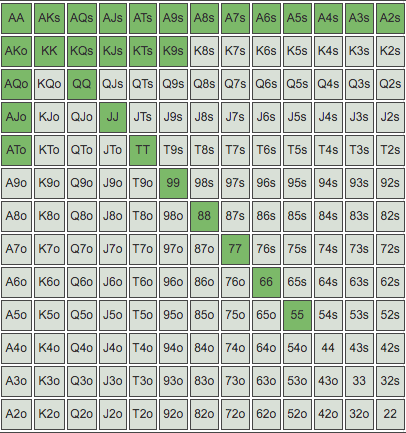With all the talk of preflop starting hand charts we look at how you can remember a range without referring to a visual aid.

There is a lot of talk about hand charts at the moment and whether a visual prompt is a crutch or even a form of cheating.
I defended (basic) charts recently but concluded that it is still probably better to study the ranges away from the table to internalise them, rather than have them on hand. I think this means you can be more fluid in your play, it will help you in live poker and if a site bans any reference material you won’t be at a disadvantage.
If you browse poker forums a lot of people ask how to memorise ranges, it is a very common query and it is something I struggled with too. I got lucky, the two books I recently wrote with Dara O’Kearney gave me a bird’s eye view on how a professional thinks about ranges, so that helped me tremendously. I do have some general tips on how you can better remember ranges when you are at the table.
The shape of a range

It’s much easier to think of types of hands in a range rather than each individual hand. So think in terms like Ax (for all the Ace hands), Broadway (for the JT-KQ type hands), pairs and suited connectors. After this, just try and remember the bottom hand in each type of hand, so if A9o and A3s are the lowest Ax hands, just memorise A9o and A3s, not every single combination. You will know automatically that AJo and A8s will be in the range. There are some spots where, for example, A6o might not be in the range but A5o would (for blocker or straight purposes), but for the most part this method works.
Another different way to think of the range instead of just logging each hand in it is by memorising the shape of the range. Most ranges are linear, meaning they start at AA then just get weaker, but some ranges are capped (meaning the top hands are missing because they would have been played more aggressively) and sometimes they are polar (meaning it is mostly big hands or weak hands but no middle hands). ICM also shapes a range, you will see more suited high cards and less offsuit broadway, small pairs and small suited connectors in the late stages of an MTT. Thinking in terms of a visual shape is an easy way to retieve a range from your memory.
Learn the why behind the range

Assuming you have created your ranges using some sort of solver technology, it would be a mistake to just follow them blindly. Learn the why behind a range to get a deeper understanding of it. If a range is split between opens and shoves, learn why the solver opened some hands and shoved the others, for example.
One thing that is incredibly valuable to do here is to study the calling ranges your opponents should have vs your opening range. For example, there may be late position ICM spots where you can shove a very wide range because your opponent should call with a very tight range. When you know how your opponent should respond, it makes it easier to develop an instinct for your betting range.
Finally just a simple memory tip. It’s natural to think the way to learn a range is to look it up and repeat it to ourselves, but memory works better when we test it. Rather than putting a hand into a solver to get a range spit back at us, it is better to look at a spot in your study, write down what you think the range should be, and then getting the answer. Memory improves more when it is being retrieved and if you are wrong, being corrected is uncomfortable but makes it more likely you will remember it next time.
“This is the single thing that makes the biggest difference in people’s results for learning anything at all…”
How To Learn & Remember Anything, Fast – now live with @AliAbdaal
Go watch
https://t.co/ct9PZLYBNF pic.twitter.com/TcbC2K3Pcm
— Chris Williamson (@ChrisWillx) October 12, 2020
How do you remember a range? Let us know in the comments:
source https://casinonewsblogger.com/how-to-memorise-a-poker-range/


No comments:
Post a Comment